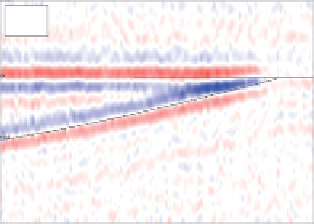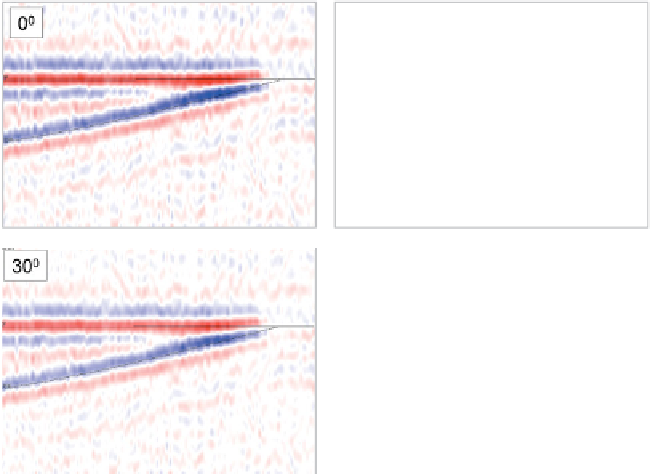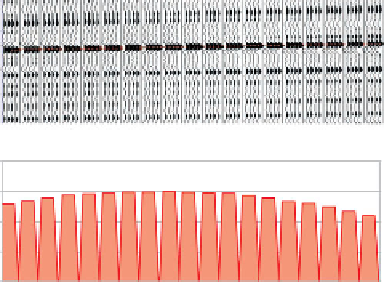Geology Reference
In-Depth Information
Figure 4.26
Wedge models of a gas
sand with various constant phase
rotations.
0º
60º
30º
1.25
1.30
1.35
1.40
1.45
signature as well as a wedge-shaped geometry owing
to the interference of the blue peaks. The difference
between the 0° and 60°cases is clear, but the difference
between the 0° and 30°cases is subtle. A general rule of
thumb is that a phase rotation of 30° is about the least
that is required to make changes to a seismic display
that are apparent to the naked eye.
When there is no well control the problem of
determining wavelet phase becomes much more dif-
ficult. In principle the answer is to look at the
response of reflectors of known impedance contrast,
such as the (hard) seabed or the tops of thick (hard)
igneous intrusions or thick (hard) carbonates over-
lain by shales. A problem in using the seabed is that
it is usually well above any target of interest, so the
phase of the wavelet may change significantly
between the seabed and the target due to absorption
effects (
Chapter 3
). Lithological contrasts are also
problematic, as the reflection from the top can easily
be modified by tuning effects in thin layers. Assum-
ing that the top reflection is truly the signature of a
single interface, then a method of phase rotation and
measurement of amplitude may give a clue to phase
(
Fig. 4.27
). The idea is that the phase rotation that
gives the highest amplitude produces seismic data
that is close to zero phase. Of course, once phase
has been addressed in this way there is still the
additional problem of inferring polarity using avail-
able geological knowledge.
0.020
0.015
0.010
0.005
0.000
Phase Rotation
Figure 4.27
Method of determining phase through phase rotation
and amplitude measurement (after Roden and Sepulveda,
1999
).
Amplitudes are measured on the peak at ~1.33 s (considered to be a
unique reflector) at phase rotations from 90° to 90° relative to the
initial phase of the seismic.
Maximum reflection stand-out is also the basis for
wavelet extraction methods that use higher order
statistics. Given that the Earth
s reflectivity is non-
Gaussian (Walden and Hosken,
1986
) one approach
is to rotate the phase of the seismic, with a constant
phase assumption, and measure the kurtosis (or devi-
ation from gaussianity) (e.g. Levy and Oldenburg,
1987
). The wavelet phase is the opposite (i.e. 180°
difference) of the phase rotation that maximises the
'
55








